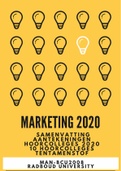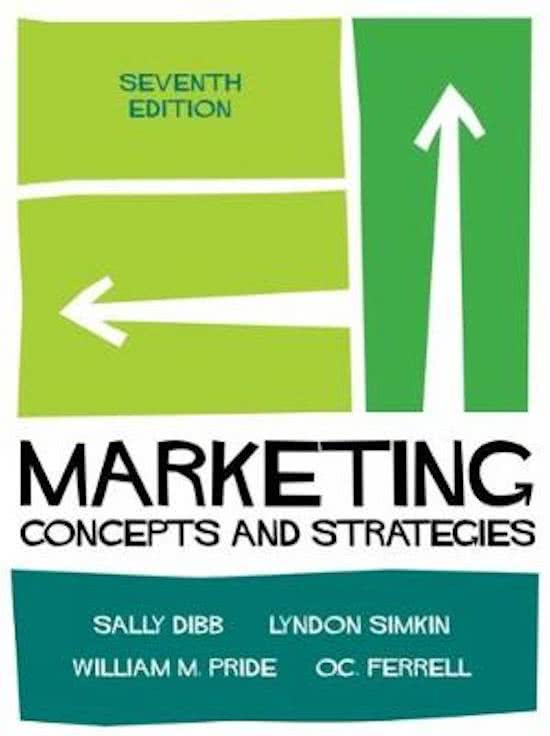,Introduction to the trial exam
This trial exam consist of 32 MC questions equally spread over all the 10 lectures and 24 chapter of
the book you needed to learn. It can provide you with a fast check if you learned enough for the
exam. All the answers and the explanation of the answers and theory are in there and the place
where you can find the answer.
Inhoud
Introduction to the trial exam .............................................................................................................2
Trial exam Marketing 2020 .................................................................................................................2
Answers trial exam marketing 2020 ....................................................................................................8
Trial exam Marketing 2020
1. What is not one of the important tasks of marketing? (Lecture 1, Chapter 1)
a. Understanding markets and develop insight in these markets
b. Creating brands and brand value proposition
c. Managing customer experience
d. Selling, communicating and creating needs
2. What is marketing management? (Lecture 1, chapter 1,2)
a. Involves challenging orthodox vies that are central to the core principles of the discipline.
b. This is the process of planning, organizing, implementing and controlling marketing
activities to facilitate and expedite exchanges effectively and efficient.
c. The systematic process of assessing marketing opportunities and resources determining
marketing objectives and developing a thorough plan for implementation and control.
d. External changing forces within the trading environment; laws, regulations, political
activities, societal pressures, economic conditions and technological advances.
e. Product, Price, Promotion (all communication), Place (Distribution) – Some add: People.
Place becomes less important, because of the digital world.
f. The selection of new opportunities to pursue and current activities to support,
identification of associated target markets and competitive positioning and creation of
value proposition and customer engagement plans, in order to deliver the specified
performance goals in the corporate strategy.
3. Why are we doing market structure analysis and competitor analysis? (Lecture 2) Select the
one that is not true.
a. Allows firms to determine which other marketing offers are competing.
b. Crucial to the Value proposition and to have a good marketing mix
c. Allows firms to be proactive
d. To make a long and complex list from everything that could happen.
,4. There is an Starbucks on the one side of the street where you can drink coffee and on the
other side of the street is a hot chocolate bar, what kind of competition do they have?
(lecture 2)
a. Product form competition
b. Product category/class competition
c. Generic competition
d. Budget competition
5. AH Netherlands thinks that elder people, Young sustainable oriented people and vegan
people will buy environmental toilet paper. Vegan people are divided in environmental
conscious and really vegetarian people. What are they doing? (Lecture 3)
a. Targeting
b. Positioning
c. Segmenting
6. NS trains do have different subscription, with discounts such as an off-peak subscription a
work subscription a student subscription. This an example of: (Lecture 3)
a. Product specialization
b. Market specialization
c. Concentrated (nish) marketing
d. Selective differentiation
7. The food of burger King is fast, clean and it is served. This is an example of: (Lecture 3)
a. POD
b. POP
8. What is not correct according to (non)probability sampling? (Lecture 4)
a. Probability sampling – Random = Like a lottery
b. Probability sampling - Stratified = Population is divided into groups, and then a
sample is selected from each group
c. Non-probability - Quota = Use criteria, to ensure the sample is spread on categories
d. Non-probability – Convenience = Hand-picked, because the researcher knows
something from the respondent.
9. What is the difference between primary and secondary data? (Chapter 9)
a. Primary data is the first you need and secondary you need afterwards
b. Primary data is the collected data and secondary the processed data
c. Primary data is collected because of you research purpose, secondary data is
collected for other purposes
d. Primary data is collected as the fundament, secondary with all kinds of details
10. What is marketing Myopia? (lecture 5, chapter 5)
a. The study of how individuals or groups buy, use and dispose goods, services, ideas or
experiences to satisfy their needs and wants.
b. That you only think on the short term, not on the real marketing need. For example
movies, but the real need is ENTERTAINMENT. You should look at the underlying
need.
c. That you think only about what someone wants, but not about if they can pay it.
d. That you expected something else than you actually got. Most people have the
tendency to reduce that.
e. The study of brain patterns to reveal responses to marketing stimuli.
, 11. The company ‘I SEGMENT’ offers products and services to a number of market segments and
develops separate marketing strategies for each segment. What targeting strategy does it
use? (lecture 2)
a. Undifferentiated marketing.
b. Differentiated marketing.
c. Multiple segment targeting
d. Customized marketing
12. Consider the following statements regarding using demographic variables for segmentation:
I) Demographic variables are difficult to measure and easy to understand. (lecture 3)
II) Demographic variables tend to predict consumer behavior less well than other types of
variables that can be used for segmentation.
III) Nationality, race, and house ownership are examples of demographic variables.
IV) The current technological developments make it possible to better predict consumer
behavior when using demographic segmentation variables.
Which of these statements are true?
a. Statement I and II
b. Statement II and III
c. Statement III and IV
d. Statement I and IV
13. Media planning is the process of (a)…………………………………… to place advertisements and
(b)………………………………………..…….
a. (a): identifying and selecting media outlets, in which (b): developing a coordinated
plan for where, when, and how often to feature a specific ad.
b. (a): selecting the right audience for whom (b): for whom to develop communication
messages.
c. (a): selecting the right target audience’s outlet, in which (b): developing a detailed
plan of what to say and what not to say in the marketing communication.
d. (a): identifying and selecting media outlets, in which (b): developing a detailed plan
of what to say and what not to say in the marketing communication
14. I believe coca-cola is the best cola you can get. I buy coca-cola. And I evaluate it. This is an
example of... (lecture 5)
a. Expectancy value theory
b. Herzberg two-factor theory
c. Non-compensatory models
15. Radboud needs a new alternative for Brightspace. They are buying from another business.
We know what the options are but we want to study alternatives. This is an example of...
a. New tasks purchase
b. Modified re buy
c. Straight re buy
16. The corona virus in in the Netherlands, and we need to wear face mask in the public
transport. So I need to buy a facemask. This is: (Chapter 5)
a. Situational involvement
b. Enduring involvement
c. Low consumer involvement






